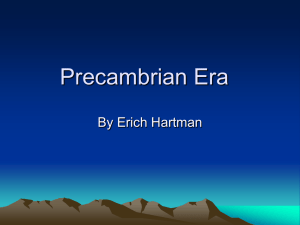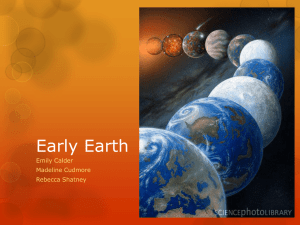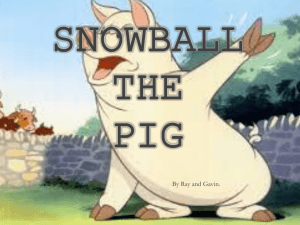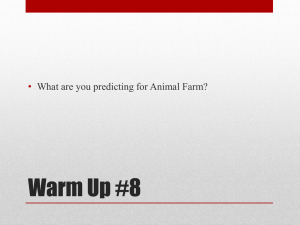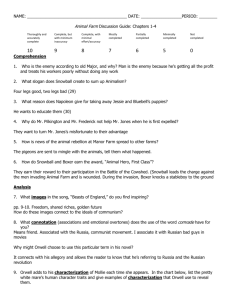SnowballEarthSeminar_2010
advertisement
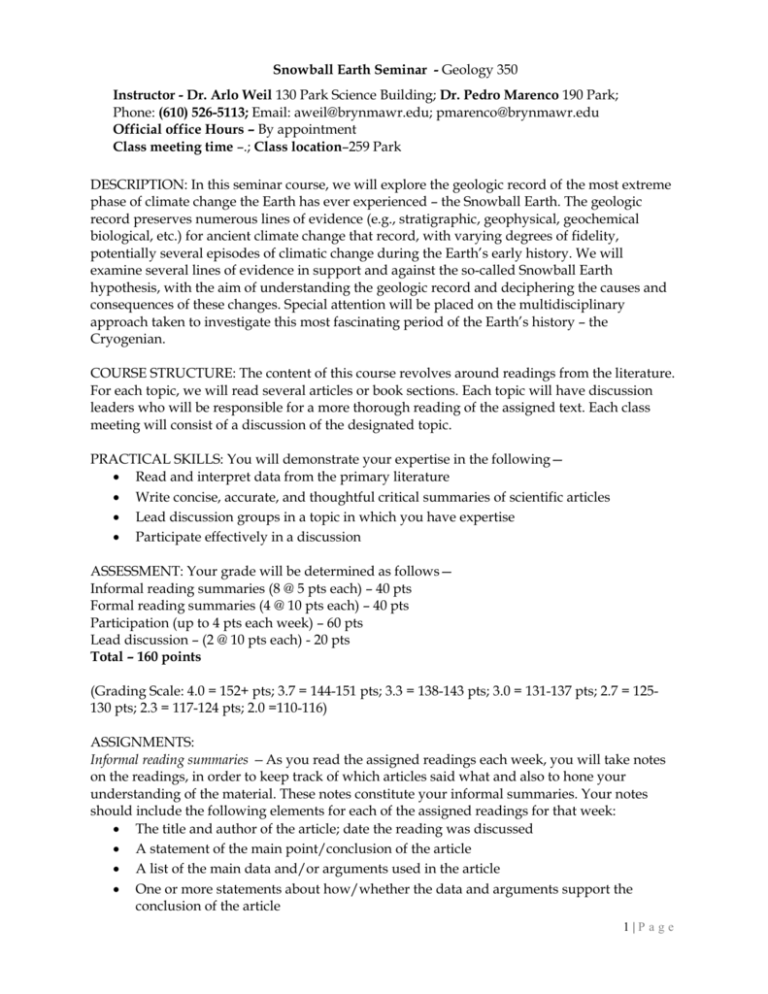
Snowball Earth Seminar - Geology 350 Instructor - Dr. Arlo Weil 130 Park Science Building; Dr. Pedro Marenco 190 Park; Phone: (610) 526-5113; Email: aweil@brynmawr.edu; pmarenco@brynmawr.edu Official office Hours – By appointment Class meeting time –.; Class location–259 Park DESCRIPTION: In this seminar course, we will explore the geologic record of the most extreme phase of climate change the Earth has ever experienced – the Snowball Earth. The geologic record preserves numerous lines of evidence (e.g., stratigraphic, geophysical, geochemical biological, etc.) for ancient climate change that record, with varying degrees of fidelity, potentially several episodes of climatic change during the Earth’s early history. We will examine several lines of evidence in support and against the so-called Snowball Earth hypothesis, with the aim of understanding the geologic record and deciphering the causes and consequences of these changes. Special attention will be placed on the multidisciplinary approach taken to investigate this most fascinating period of the Earth’s history – the Cryogenian. COURSE STRUCTURE: The content of this course revolves around readings from the literature. For each topic, we will read several articles or book sections. Each topic will have discussion leaders who will be responsible for a more thorough reading of the assigned text. Each class meeting will consist of a discussion of the designated topic. PRACTICAL SKILLS: You will demonstrate your expertise in the following— Read and interpret data from the primary literature Write concise, accurate, and thoughtful critical summaries of scientific articles Lead discussion groups in a topic in which you have expertise Participate effectively in a discussion ASSESSMENT: Your grade will be determined as follows— Informal reading summaries (8 @ 5 pts each) – 40 pts Formal reading summaries (4 @ 10 pts each) – 40 pts Participation (up to 4 pts each week) – 60 pts Lead discussion – (2 @ 10 pts each) - 20 pts Total – 160 points (Grading Scale: 4.0 = 152+ pts; 3.7 = 144-151 pts; 3.3 = 138-143 pts; 3.0 = 131-137 pts; 2.7 = 125130 pts; 2.3 = 117-124 pts; 2.0 =110-116) ASSIGNMENTS: Informal reading summaries —As you read the assigned readings each week, you will take notes on the readings, in order to keep track of which articles said what and also to hone your understanding of the material. These notes constitute your informal summaries. Your notes should include the following elements for each of the assigned readings for that week: The title and author of the article; date the reading was discussed A statement of the main point/conclusion of the article A list of the main data and/or arguments used in the article One or more statements about how/whether the data and arguments support the conclusion of the article 1|P age Questions that you have about the data, arguments, or conclusions You must hand in at least 8 of these summaries throughout the term. They are due on the day the topic is discussed in class and cannot be handed in late. You may hand them in typed or handwritten – in whatever format you take the notes in. You do not need to use complete sentences; these are essentially your notes. You should, however, use a highlighter to mark the important elements, so that we can find them (and so that you can find them while you’re discussing the article in class). Formal reading summaries —These assignments represent the next step in understanding an article from the literature. For these, you will write a 400-600 word summary of an article, containing the elements included in your informal summary. This time, though, you will spend some time organizing and communicating the elements of your summary in a logical framework. Accuracy, clarity, completeness, style and grammar all matter. You must turn in at least four formal summaries. The 1st must be handed in by week 4; the 2nd by week 8; the 3rd by week 12; and the 4th by the last week of classes. Participation —Because this course centers on in-class discussions, the participation grade is the largest single element in your grade. You are expected to come to class (on time), demonstrate that you have done the assigned reading for the week, and contribute meaningfully to the discussion by asking questions, venturing ideas, or otherwise interacting with your classmates. You will be evaluated as follows: 2 pt for demonstrating that you read the material; 2 pt for participating meaningfully in the discussion. There are 60 possible points for this element, which corresponds to 15 class meetings at full credit. Lead discussion —For each class meeting, two students will be designated as discussion leaders. These students will be responsible for a thorough reading of all assigned text. Each leader will present a brief summary of the topic, splitting the assigned readings between them. Following the summary, leaders should manage the discussion of the material, prompting further discussion and engaging the rest of the class in the topic. Dates for topics will be provided in the third week of class. RULES OF CONDUCT: Because the learning in this course takes place during discussions with one another, it is very important that you be respectful of each other. The attitudes and behavior of every member of this class will affect the environment of the classroom. Be respectful and supportive of your classmates. There are no dumb ideas – there are wrong ideas, but that is not the same thing. At some point, each person in the class will be the ―expert, and each will struggle with the material. It is your responsibility to be fully ―present in the classroom. Turn off cell phones; do not text during class. Come prepared and pay attention in class. If you use a laptop in class, it should only be used for class-related work (e.g., taking notes electronically is fine; surfing the web or downloading music during class is not). Music players have no business in class, and the only things hanging from your ears or neck should be decorative. The line between productive collaboration and plagiarism (copying) is often a difficult one to identify. While I expect you to work together to understand and evaluate the course material, the work handed in with your name on it must be your own. Do not copy another student’s notes or formal work. Never copy and paste text from an article or from a website into work that you are creating, even if you cite it. 2|P age Weekly Topic/Reading list: Those references that in BOLD with an asterisk are REQUIRED reading for each week. All readings can b e found at the following web link: http://www.brynmawr.edu/geology/snowball/ Week 1 (January 18th): Introduction Week 2 (January 25th): Historical Background and Early Ideas Caldeira, K. and Kasting, J.F. 1992. Susceptibility of the early Earth to irreversible glaciation caused by carbon dioxide clouds. Nature 359: 226-228. Crawford, AR, and Daily, B. 1971. Probable non-synchroneity of Late Precambrian glaciations. Nature 230: 111-112. *Roberts, J.D., 1976. Late Precambrian dolomites, Vendian glaciation, and synchroneity of Vendian glaciations. Journal of Geology 84, 47-63. *Harland, W.B., and Rudwick, M.J.S. 1964. The great infra-Cambrian ice-age. Scientific American 211:28-36. *Hoffman, P.F., Kaufman, A.J., Halverson, G.P., and Schrag, D.P. 1998. A Neoproterozoic snowball Earth. Science 281: 1342-1346. *Kirschvink, J. L., 1992. Late Proterozoic low-latitude global glaciation: the snowball Earth, In J. W. Schopf and C. Klein, eds, The Proterozoic Biosphere: A multidisciplinary study, Cambridge University Press, Cambridge NY, pp. 51-52. Kuhn, W.R. 1992. Avoiding a permanent ice age. Nature 359: 196-197. (News and Views for Caldeira and Kasting) Week 3 (February 1st): Paleolatitudes and Paleomagnetism *Li, Z.X., 2000. New plaeomagnetic results from the ‘cap dolomite’ of the Neoproterozoic Walsh Tillite, northwestern Australia. Precambrian Research 100, 359-370. McElhinny, M.W., Giddings, J.W. & Embleton, B.J.J., 1974. Palaeomagnetic results and late Precambrian glaciations. Nature 248, 557-561. *Meert, J.G. & van der Voo, R., 1994. The Neoproterozoic (1000-540 Ma) glacial intervals: no more snowball Earth? Earth and Planetary Science Letters 123, 1-13. Park, J.K., 1997. Paleomagnetic evidence for low-latitude glaciation during deposition of the Neoproterozoic Rapitan Group, Mackenzie Mountains, N.W.T., Canada. Canadian Journal of Earth Sciences 34, 34-49. Schmidt, P.W. & Williams, G.E., 1995. The Neoproterozoic climatic paradox: Equatorial paleolatitude for Marinoan glaciation near sea level in South Australia. Earth and Planetary Science Letters 134, 107-124. Schmidt, P.W. & Williams, G.E., 1999. Paleomagnetism of the Paleoproterozoic hematitic breccia and paleosol at Ville-Marie, Québec: further evidence for the low paleolatitude of Huronian glaciation. Earth and Planetary Science Letters 172, 273-285. 3|P age *Sohl, L.E., Christie-Blick, N. & Kent, D.V., 1999. Paleomagnetic polarity reversals in Marinoan (ca 600 Ma) glacial deposits of Australia: implications for the duration of low-latitude glaciation in Neoproterozoic time. Geological Society of America Bulletin 111, 1120-1139. Torsvik, T.H., Lohmann, K.C., & Sturt, B.A., 1995. Vendian glaciations and their relation to the dispersal of Rodinia: paleomagnetic constraints. Geology 23, 727-730. Williams, G.E. & Schmidt, P.W., 1997. Paleomagnetism of the Palaeoproterozoic Gowganda and Lorrain formations, Ontario: low paleolatitude for Huronian glaciation. Earth and Planetary Science Letters 153, 157-169. *Williams, G.E., Schmidt, P.W., & Embleton, B.J.J., 1995. Comment on ‘The Neoproterozoic (1000540 Ma) glacial intervals: No more snowball earth? By Joseph G. Meert and Rob van der Voo. Earth and Planetary Science Letters 131, 115-122. Week 4 (February 8th): Timing and Extent of Proterozoic Glaciations *Bodiselitsch, B., Koeberl, C., Master, S., and Reimold, W.U., 2005. Estimating duration and intensity of Neoproterozoic snowball glaciations from Ir anomalies. Science 308. 239-242. *Condon, D., Zhu, M., Bowring, S.A., Wang, W., Yang, A., and Jin, Y., 2005. U-Pb ages from the Neoproterozoic Doushantuo Formation, China. Science 308, 95-98. Fanning, C.M. and Link, P.K., 2004. U-Pb SHRIMP ages of Neoproterozoic (Sturtian) glaciogenic Pocatello Formation, southeastern Idaho. Geology 32, 881-884, doi:10.1130/G20609.1 *Hoffmann, K.-H., Condon, D.J., Bowring, S.A., and Crowley, J.L., 2004. U-Pb zircon date from the Neoproterozoic Ghaub Formation, Namibia: constraints on Marinoan glaciation. Geology 32, 817820, doi:10.1130/G20519.l *Kaufman, A.J., Knoll, A.H. & Narbonne, G.M., 1997. Isotopes, ice ages, and terminal Proterozoic Earth history. Proceedings of the National Academy of Sciences 94, 6600-6605. *Kennedy, M.J., Runnegar, B., Prave, A.R., Hoffmann, K.-H. &Arthur, M.A., 1998. Two or four Neoproterozoic glaciations? Geology 26, 1059-1063. Kerr, R. 2005. Cosmic dust supports a snowball Earth. Science 308, 181. (News and Views for Bodiselitsch et al.) Sohl, L.E., Christie-Blick, N. & Kent, D.V., 1999. Paleomagnetic polarity reversals in Marinoan (ca 600 Ma) glacial deposits of Australia: implications for the duration of low-latitude glaciation in Neoproterozoic time. Geological Society of America Bulletin 111, 1120-1139. Zhang, S., Jiang, G., Zhang, J., Song, B., Kennedy, M.J., and Christie-Blick, N., 2005. U-Pb sensitive high-resolution ion microprobe ages from the Doushantuo Formation in south China: constraints on late Neoproterozoic glaciations. Geology 33, 473-476. Week 5 (February 15th): The Sediment Record *Condon, D.J., Prave, A.R. & Benn, D.I., 2002. Neoproterozoic glacial-rainout intervals: observations and implications. Geology 30, 35-38. *Giddings, J.A. & Wallace, M.W., 2009. Sedimentology and C-isotope geochemistry of the 'Sturtian' cap carbonate, South Australia. Sedimentary Geology, 216, 1-14. 4|P age *Prave, A.R., 1999. Two diamictites, two cap carbonates, two 13C excursions, two rifts: The Neoproterozoic Kingston Peak Formation, Death Valley, California. Geology 27, 339-342. Young, G.M., 2002. Stratigraphic and tectonic settings of Proterozoic glaciogenic rocks and banded iron-formations: relevance to the snowball Earth debate. Journal of African Earth Sciences 35, 451-466. Week 6 (February 22nd): Ironstones and BIFs Klein, C. and Ladeira, E.A., 2004. Geochemistry and mineralogy of Neoproterozoic banded ironformations and some selected, siliceous manganese formations from the Urucum District, Mato Grosso do Sul, Brazil. Economic Geology 99, 1233-1244. *Kump, L.R. and Seyfried, W.E., Jr., 2005. Hydrothermal Fe fluxes during the Precambrian: effect of low oceanic sulfate concentrations and low hydrostatic pressure on the composition of black smokers. Earth and Planetary Science Letters 235, 654-662. *Lottermoser, B.G. and Ashley, P.M., 2000. Geochemistry, petrology and origin of Neoproterozoic ironstones in the eastern part of the Adelaide Geosyncline, Precambrian Research 101, 49-67. *Young, G.M., 2002. Stratigraphic and tectonic settings of Proterozoic glaciogenic rocks and banded iron-formations: relevance to the snowball Earth debate. Journal of African Earth Sciences 35, 451-466. Week 7 (March 1st): Cap Carbonates and what they mean Allen, P.A., and Hoffman, P.F. 2005. Extreme winds and waves in the aftermath of a Neoproterozoic glaciation. Nature 433:123-127. *Corsetti, F. A. and J. P. Grotzinger (2009). "Origin and Significance of Tube Structures in Neoproterozoic Post-glacial Cap Carbonates: Example from Noonday Dolomite, Death Valley, United States." PALAIOS 20(4): 348-362. Jerolmach, D.J. and Mohrig, D. 2005. Formation of Precambrian sediment ripples. Nature 436:E1. (Comment) *Kennedy, M. J., 1996. Stratigraphy, sedimentology, and isotopic geochemistry of Australian neoproterozoic postglacial cap dolostones: Deglaciation, ∂13C, and carbonate precipitation, Journal of Sedimentary Research , 66(6), pp. 1050-1064. Nogueira, A.C.R., Riccomini, C., Sial, A.N., Moura, C.A.V., and Fairchild, T.R. 2003. Soft-sediment deformation at the base of the Neoproterozoic uga cap carbonate (southwestern Amazon craton, Brazil): confirmation of rapid icehouse to greenhouse transition in snowball Earth. Geology 31: 613616. *Ridgwell, A.J., Kennedy, M.J. Caldeira, K., 2003. Carbonate deposition, climate stability, and Neoproterozoic ice ages. Science 302, 859-862. Week 8 (March 8th): Spring Break – Death Valley Trip Week 9 (March 15th): Geochemistry part 1—Carbon Isotopes *Kennedy, M.J., Christie-Blick, N., and Sohl, L.E. 2001. Are Proterozoic cap carbonates and isotopic excursions a record of gas hydrate destabilization following Earth’s coldest intervals? Geology 29:443-446. 5|P age Halverson, G.P., Hoffman, P.F., Schrag, D.P. & Kaufman, J.A., 2002. A major perturbation of the carbon cycle before the Ghaub glaciation (Neoproterozoic) in Namibia: Prelude to snowball Earth? Geophysics, Geochemistry, Geosystems 3, on-line 10.1029/2001GC000244. *Halverson, G.P., Hoffman, P.F., Schrag, D.P., Maloof, A.C., & Rice, A.H.N., 2005. Toward a Neoproterozoic composite carbon-isotope record. Geological Society of America Bulletin 117, 11811207, 10.1130/B25630.1 *Hoffman, P.F., Halverson, G.P., and Grotzinger, J.P. 2002. Are Proterozoic cap carbonates and isotopic excursions a record of gas hydrate destabilization following Earth’s coldest intervals? Comment. Geology 30: 286-287. *Jiang, G., Kennedy, M.J., and Christie-Blick, N. 2003. Stable isotopic evidence for methane seeps in Neoproterozoic postglacial cap carbonates. Nature 426:822-286. *Kaufman, A. J. and A. H. Knoll (1995). "Neoproterozoic variations in the C-isotopic composition of seawater; stratigraphic and biogeochemical implications." Precambrian Research 73(1-4): 27-49. Kaufman, A.J., Knoll, A.H. & Narbonne, G.M., 1997. Isotopes, ice ages, and terminal Proterozoic earth history. Proceedings of the National Academy of Sciences 94, 6600-6605. Kennedy, M. J., 1996. Stratigraphy, sedimentology, and isotopic geochemistry of Australian neoproterozoic postglacial cap dolostones: Deglaciation, 13C, and carbonate precipitation, Journal of Sedimentary Research , 66(6), pp. 1050-1064. Kennedy, M.J., Christie-Blick, N. & Prave, A.R., 2001. Carbon isotopic composition of Neoproterozoic glacial carbonates as a test of paleoceanographic models for snowball Earth phenomena. Geology 29, 1135-1138. *Kennedy, M.J., Christie-Blick, N., and Sohl, L.E. 2002. Are Proterozoic cap carbonates and isotopic excursions a record of gas hydrate destabilization following Earth’s coldest intervals? Reply. Geology 30: 287-288. Week 10 (March 22nd): Geochemistry part 2--Other geochemical systems) *Hurtgen, M.T., Arthur, M.A., Suits, N.S., & Kaufman, A.J., 2002. The sulfur isotopic composition of Neoproterozoic seawater sulfate: implications for a snowball Earth? Earth and Planetary Science Letters 203, 413-429. Kasemann, S.A., Hawkesworth, C.J., Prave, A.R., Fallick, A.E., and Pearson, P.N., 2005. Boron and calcium isotope composition in Neoproterozoic carbonate rocks from Namibia: evidence for extreme environmental change. Earth and Planetary Science Letters 231, 73-86. *Jacobsen, S.B., and Kaufman, A.J., 1999, The Sr, C and O isotopic evolution of Neoproterozoic seawater: Geochemica acta Cosmochemica, v. 161, p. 37-57. *McFadden, K.A., Huang, J., Chu, X., Jiang, G., Kaufman, A.J., Zhou, C., Yuan, X., and Xiao, S., 2008, Pulsed oxidation and biological evolution in the Ediacaran Doushantuo Formation: Proceedings of the National Academy of Sciences, v. 105, p. 3197-3202. Week 11 (March 29nd): Modeling and Testing a Snowball Earth Condon, D.J., Prave, A.R. & Benn, D.I., 2002. Neoproterozoic glacial-rainout intervals: observations and implications. Geology 30, 35-38. 6|P age *Hyde, W.T., Crowley, T.J., Baum, S.K. & Peltier, W.R., 2000. Neoproterozoic ‘snowball Earth’ simulations with a coupled climate/ice-sheet model. Nature 405, 425-429. Warren, S.G., Brandt, R.E., Grenfell, T.C. & McKay, C.P., 2002. Snowball Earth: Ice thickness on the tropical ocean. Journal of Geophysical Research 107, 10.1029/2001JC001123. *Pierrehumbert, R.T., 2004. High levels of atmospheric carbon dioxide necessary for the termination of global glaciation. Nature 429, 646-649. *Poulsen, C.J., 2003. Absence of a runaway ice-albedo feedback in the Neoproterozoic. Geology 31, 473-476. *Donnadieu, Y., Goddéris, Y., Ramstein, G., Nédélec, A., & Meert, J., 2004. A ‘snowball Earth’ climate triggered by continental break-up through changes in runoff. Nature 428, 303-306. Pollard, D. and Kasting, J.F., 2005. Snowball Earth: a thin-ice solution with flowing glaciers. Journal of Geophysical Research 110, C07010, 10.1029/2004JC002525 Week 12 (April 5th): Life during a Snowball Brocks, J.J. & Butterfield, N.J., 2009. Early animals out in the cold. Nature 457, 672-673. Canfield, D.E., Poulton, S.W., & Narbonne, G.M., 2006. Late-Neoproterozoic deep-ocean oxygenation and the rise of animal life. Science, 315,92-95. *Corsetti, F.A., Awramik, S.M., and Pierce, D. 2003. A complex microbiota from snowball Earth times: microfossils from the Neoproterozoic Kingston Peak Formation, Death Valley, USA. Proceedings of the National Academy of Sciences, USA 100(8): 4399-4404. *Corsetti, F.A., Olcott, A.N., and Bakermans, C. In Press. The biotic response to Neoproterozoic snowball Earth. Palaeogeography, Palaeoclimatology, Palaeoecology. *Gaidos, E.J., Nealson, K.H., & Kirschvink, J.L., 1999. Life in ice-covered oceans. Science 284, 16311633. Grey, K., Walter, M.R., and Calver, C.R. 2003. Neoproterozoic biotic diversification: Snowball Earth or aftermath of the Acraman impact? Geology 31(5): 459-462. Kirschvink, J.L., Gaidos, E.J., Bertani, L.E., Beukes, N.J., Gutsmer, J., Maepa, L.N. & Steinberger, R.E., 2000. Paleoproterozoic snowball Earth: extreme climatic and geochemical global change and its biological consequences. Proceedings of the National Academy of Sciences 97, 1400-1405. Moczydlowska, M., 2008. The Ediacaran microbiota and the survival of Snowball Earth conditions. Precambrian Research 167, 1-15. *Olcott, A.N., Sessions, A.L., Corsetti, F.A., Kaufman, A.J., & de Oliveira, T.F., 2005. Biomarker evidence for photosynthesis during Neoproterozoic glaciation. Science 310, 471-474. *Runnegar, B. 2000. A loophole for snowball Earth. Nature 405:403-404. *Xiao, S., 2004. Neoproterozoic glaciations and the fossil record. In: Jenkins, G.S., McMenamin, M.A.S., McKey, C.P., and Sohl, L. (eds.) The Extreme Proterozoic: Geology, Geochemistry, and Climate. Geophysical Monograph 146, American Geophysical Union, Washington, DC., p. 199-214. 7|P age Week 13 (April 12th): Alternative Ideas Eyles, N. and Januszczak, N., 2004. ‘Zipper-rift’: a tectonic model for Neoproterozoic glaciations during the breakup of Rodinia after 750 Ma. Earth-Science Reviews 65, 1-73. Hoffman, P.F. 1999. ‘Snowball Earth’ theory still stands. Nature 400: 708. (Reply) Hoffman, P.F. and Maloof, A.C. 1999. Glaciation: the snowball theory still holds water. Nature 397:384. (Comment) *Williams, D.M., Kasting, J.F., Frakes, L.A. 1998. Low-latitude glaciation and rapid changes in the Earth’s obliquity explained by obliquity-oblateness feedback. Nature 396: 453-455. *Williams, G.E. 1975. Late Precambrian glacial climate and the Earth’s obliquity. Geological Magazine 112, 441-465. Williams, G.E. 1999. Going cold on ‘snowball Earth’ theory. Nature 398:555-556. (Comment) Week 14 (April 19th): Triggers for a Snowball Event Goddéris, Y., Donnadieu, Y., Nédélec, A., Dupré, B., Dessert, C., Grard, A., Ramstein, G. & Francois, L.M., 2003. The Sturtian ‘snowball’ glaciation: fire and ice. Earth and Planetary Science Letters 211, 112. *Li, Z.X., Evans, D.A.D., and Zhang, S., 2004. A 90º spin on Rodinia: possible causal links between the Neoproterozoic supercontinent, superplume, true polar wander and low-latitude glaciation. Earth and Planetary Science Letters 220, 409-421. *Pavlov, A.A., Hurtgen, M.T., Kasting, J.F., and Arthur, M.A., 2003. Methane-rich Proterozoic atmosphere? Geology 31, 87-90. Pavlov, A.A., Toon, O.B., Pavlov, A.K., Bally, J., and Pollard, D. 2005. Passing though a giant molecular cloud: “Snowball” glaciations produced by interstellar dust. Geophysical Research Letters 32(3), L03705, doi:10.1029/2004GL021890. *Schrag, D.P., Berner, R.A., Hoffman, P.F., and Halverson, G.P. 2002. On the initiation of a snowball Earth. Geochemistry, Geophysics, Geosystems 3(6). Week 15 (April 26th): Summary and Review – What’s Next? *Grotzinger, J. P. and A. H. Knoll (1995). "Anomalous carbonate precipitates; is the Precambrian the key to the Permian?" Palaios 10(6): 578-596. *Harland, W.B., 2007. Origins and assessment of snowball Earth hypotheses. Geological Magazine 144, 633-642. Hoffman, P.F. & Schrag, D.P., 2000. Snowball Earth. Scientific American 282, 68-75. Hoffman, P.F. and Schrag, D.P. 2002. The snowball Earth hypothesis: testing the limits of global change. Terra Nova 14:129-155. *Knoll, A. H., R. K. Bambach, et al. (1996). "Comparative Earth history and Late Permian mass extinction." Science 273(5274): 452-457. 8|P age

